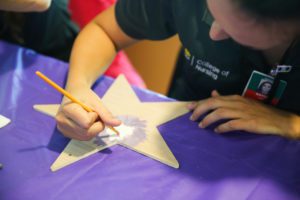MedPACt Conference Focuses On Arts And Healing
- COLLEGE OF MEDICINE GLOBAL HEALTH
BY MEGAN SCAVO | JANUARY 23, 2020 2:38 PM
Art, whether it’s a painting, music, performance or simply enjoying another’s creativity, has a place in medicine and healing. That was the message of the 9th Annual Global Health Conference at the UCF College of Medicine, January 18.
The conference, organized by MedPACt (Medical Students Providing Across Continents), attracted more than 230 attendees from across Florida and the nation – the largest number of participants in the conference’s history. Guests included students, professors, physicians and researchers who talked about the role that arts can play in providing care worldwide.
Keynote speaker Jill Sonke, from the University of Florida Center for Arts in Medicine, stressed the need to, “think about the whole-person’s healthcare. The arts have a place – not just as an additive in comprehensive care.”
Sonke shared video of students in University of Florida’s “artists in residence” program playing music for patients at UF Health Shands Hospital. Some patients listened to the music, which spanned all genres and included a live guitarist and vocalist, while others sang along.
“The joy of the experience is a great counter-balance to their other days,” Sonke said.
Mausam Mehta, a speaker at the conference and student at the University South Florida Morsani College of Medicine, agreed that music can have a powerful healing effect.
“I believe that everyone needs something to keep them grounded in life, especially during stressful times,” Mehta said. “For me, that ‘something’ is art, specifically music, and I’m sure for many patients, the same holds true.”
The healing effects of the arts go way beyond hospital walls, as showcased by Stars of Hope, a nation-wide community arts program that held a workshop at this year’s conference.
Stars of Hope uses art to empower people to transform their communities and themselves. The organization asks participants to paint stars with messages of healing that are kept in a “hope bank” and shipped to places in need when a tragedy occurs. The stars painted at this year’s Global Health Conference will go to Australia, Puerto Rico and the Bahamas as those areas recover from natural disasters.
Stephanie Wray works as an art therapy consultant for the organization and also teaches art therapy at the University of Tampa. She explained how the simple act of painting a star for someone in need not only helps to heal the receiver, but also the giver.
“Making art builds resilience, helps people establish goals, heightens one’s sense of perception and boosts endorphins,” Wray said, “and those receiving the stars often say it’s the first time they’ve smiled since the tragedy.”
A goal of the event was to raise awareness about the need for more arts-in-medicine programs worldwide. Arts programs are gaining popularity in this country, said Vincent Cendan, a UCF medical student and one of this year’s conference directors, but he added that there is still much progress to be made outside of the U.S.
“While arts in medicine is becoming better understood and represented in Western hospitals today, investigating the use of arts in medicine as a healthcare practice abroad has only just begun,” Cendan said.
Cendan urged students to get involved in both local and global, “glocal” as he calls them, healthcare projects.
UCF medical students get plenty of opportunities to give back “glocally.” They work with UCF College of Nursing and College of Health Professions and Sciences faculty and students to run a clinic for farmworkers in Apopka. Interdisciplinary students and faculty also travel to the rural community of Yantaló, Peru to care for and educate people in the remote area. Proceeds from this year’s Global Health conference will support these efforts.
In addition to multiple workshops, panel discussions and poster presentations centered on arts in medicine, conference guests also participated in a simulated disaster aimed at teaching them how to triage patients in emergency situations. Student actors covered in fake blood and burn wounds spanned the college’s courtyard with police sirens blaring and people shouting for help.
